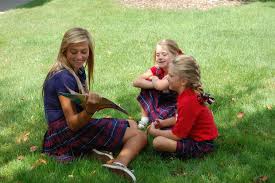Have you come across this phrase before? It has intrigued me for years. I like the alliterative quality, I like the hints of other words (doctrine from docendo; discipline from discimus). By teaching we learn—really? Surely, we have to learn first then, teach—we get degrees in college so we can teach—right?
Here we encounter an educational paradox. The way to become a great teacher is to remain a student; the way to become a great student is to teach. This Latin motto has been around for centuries and is the motto of colleges and training centers in many places—just Google it (Central Washington College, University of Defense—Czech Republic). If this is a bit of perennial wisdom, why is it so rarely implemented in our schools? Why don’t the upper school students spend some time teaching the younger students? Why don’t students teach occasional sections in their own classes? Several good things can result: teachers get a small break (but then they should observe and assess the teaching of their students); other students will enjoy the change; the presenting student will be on her toes (for it will be a performance of sorts); the presenting student will apparently learn more by having to teach. This seems to me a win-win-win.
Of course, some schools and homeschools are engaged in docendo discimus. Schools that cycle through history, repeating the teaching of historical periods in later grades, can have older students come down to the younger grades to teach history. If the ninth graders and fourth graders are studying medieval history—you can imagine the opportunity. Certainly older students can teach younger students Latin, grammar and mathematics, under the supervision of the class teacher. Students can check homework, meet one-on-one to coach younger students, and occasionally present before an entire class. Older students can even help reinforce reading skills by reviewing letter, phonemes, and words; many schools have “reading buddies”—older students who pair off with younger students and read aloud to younger readers weekly.
This pedagogy harkens back to the traditional one-room schoolhouse on the prairie. With a diverse group of students of varying ages all in one room, the teachers naturally employed older students as junior teachers who would teach younger students, while the teacher would work with another group. As the younger students matured and aged, they naturally would begin to teach those students younger than they. By teaching, they learned.
Now what is a homeschool but a kind of one-room schoolhouse? Yet some homeschool parents (I think because of their own educations) find it hard to imagine that their older students should teach much or at all. Naturally, as parents and teachers, we should be focused on the quality of teaching to any student—and perhaps having a student teach a student diminishes quality. If so, which student loses quality? Certainly not the student teaching—not if the maxim holds true—for if he teaches he learns. If the younger student receiving the teaching of an older one is not taught so well, then we should have him teach another still younger, as soon as possible. Even the younger ones aspire to this, do they not? How often do the seven-year olds instruct the five-year olds at play or during recess? How often do young girls line up their dolls and teach?









